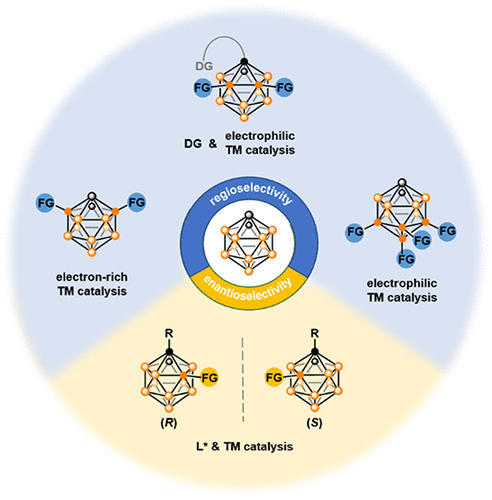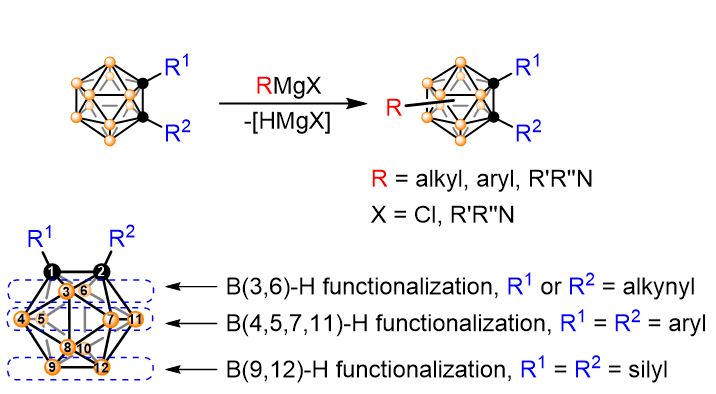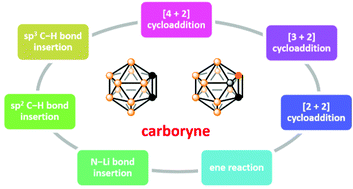1. Controlled Functionalization of Carboranes
Selective Cage B–H Activation and Functionalization
In view of o-carborane cage polarity induced by the difference in electronegativity between carbon and boron elements [the order of the vertex charge follows B(9,12)-H > B(8,10)-H > B(4,5,7,11)-H >> B(3,6)-H], we propose a general strategy to tackle the selectivity issue by means of organometallic chemistry through a good match of vertex charge with the nature of transition metal catalysts. Successful applications of such a strategy in our laboratory have resulted in the development of a series of methods for selective catalytic cage B–H functionalization, leading to the preparation of a large variety of cage B-functionalized carborane derivatives in a regioselective and catalytic manner. Meanwhile, asymmetric synthesis of chiral-at-cage o-carboranes can be achieved by enantioselective B–H activation/functionalization.
In view of o-carborane cage polarity induced by the difference in electronegativity between carbon and boron elements [the order of the vertex charge follows B(9,12)-H > B(8,10)-H > B(4,5,7,11)-H >> B(3,6)-H], we propose a general strategy to tackle the selectivity issue by means of organometallic chemistry through a good match of vertex charge with the nature of transition metal catalysts. Successful applications of such a strategy in our laboratory have resulted in the development of a series of methods for selective catalytic cage B–H functionalization, leading to the preparation of a large variety of cage B-functionalized carborane derivatives in a regioselective and catalytic manner. Meanwhile, asymmetric synthesis of chiral-at-cage o-carboranes can be achieved by enantioselective B–H activation/functionalization.

Ref.: Zaozao Qiu and Zuowei Xie. A Strategy for Selective Catalytic B–H Functionalization of o-Carboranes. Acc. Chem. Res. 2021, 54, 4065-4079.
Selective Nucleophilic Substitution Reaction of Cage B-H(s)
Carboranes can be viewed as 3D analogues to benzene. Nucleophilic substitution reaction in benzene and carborane is very rare. Recently, we have discovered that the introduction of electron-withdrawing group to cage carbons can facilitate nucleophilic substitution reaction of cage BH with organomagnesium reagents, leading to a series of B(4)-alkylated/aminated, B(3,6)-dialkylated and B(9)-alkylated/arylated o-carboranes in high yields. The regioselectivity of such nucleophilic substitution can be controlled by elaborately tuning the electronic and/or steric properties of the substituents at two cage carbons. We plan to build a toolbox of transition-metal-free methods for the preparation of a new class of cage B-substituted o-carboranes at selected cage boron position(s).
Carboranes can be viewed as 3D analogues to benzene. Nucleophilic substitution reaction in benzene and carborane is very rare. Recently, we have discovered that the introduction of electron-withdrawing group to cage carbons can facilitate nucleophilic substitution reaction of cage BH with organomagnesium reagents, leading to a series of B(4)-alkylated/aminated, B(3,6)-dialkylated and B(9)-alkylated/arylated o-carboranes in high yields. The regioselectivity of such nucleophilic substitution can be controlled by elaborately tuning the electronic and/or steric properties of the substituents at two cage carbons. We plan to build a toolbox of transition-metal-free methods for the preparation of a new class of cage B-substituted o-carboranes at selected cage boron position(s).

Ref.: Jie Zhang, and Zuowei Xie. N-Ligand-Enabled Aromatic Nucleophilic Amination of 1,2-Diaryl-o-Carboranes with (R2N)2Mg for Selective Synthesis of 4-R2N-o-Carboranes and 2-R2N-m-Carboranes. Angew. Chem. Int. Ed. 2022, 61, e202202675.
Selective Cage C Functionalization
Carborynes (1,2-dehydro-o-carboranes and 1,3-dehydro-o-carboranes), three-dimensional analogues to benzyne, are a class of very useful synthons for the synthesis of a large variety of functionalized carborane derivatives. There is a correspondence between the reactions of carborynes and those of benzyne with alkenes, dienes, alkynes, aromatics or heteroaromatics in pericyclic reaction fashions. On the other hand, carborynes have the unique properties of their own owing to their steric/electronic features. They undergo regioselective sp2/sp3 C–H bond and N–Li bond insertion reactions, which has not been observed for benzyne. We are developing new and efficient carboryne precursors and exploring their new reactivity patterns.
Carborynes (1,2-dehydro-o-carboranes and 1,3-dehydro-o-carboranes), three-dimensional analogues to benzyne, are a class of very useful synthons for the synthesis of a large variety of functionalized carborane derivatives. There is a correspondence between the reactions of carborynes and those of benzyne with alkenes, dienes, alkynes, aromatics or heteroaromatics in pericyclic reaction fashions. On the other hand, carborynes have the unique properties of their own owing to their steric/electronic features. They undergo regioselective sp2/sp3 C–H bond and N–Li bond insertion reactions, which has not been observed for benzyne. We are developing new and efficient carboryne precursors and exploring their new reactivity patterns.

Ref.: Zaozao Qiu and Zuowei Xie. Functionalization of o-Carboranes via Carboryne Intermediates. Chem. Soc. Rev. 2022, 51, 3164-3180.
Carborynes can be trapped by transition metals to form stable metal-carboryne complexes whose reactivity can be tuned by electronic configuration of the metal centers.
Ref.: Zaozao Qiu, Shikuo Ren, and Zuowei Xie. Transition Metal-Carboryne Complexes: Synthesis, Bonding, and Reactivity. Acc. Chem. Res. 2011, 44, 299-309.
2. Supercarboranes
The chemistry of boron clusters has been dominated by icosahedral carboranes over half a century. On the contrary, the chemistry of supercarboranes (carboranes with more than 12 vertices) is much less developed. We have developed the methods for the preparation of supercarboranes and studied their reaction chemistry. We plan to invent new synthetic methods to prepare carboranes having 17 vertices or more, and exploring systematically the rich reaction chemistry of supercarboranes on the basis of our previous achievements.
Ref.: Jian Zhang and Zuowei Xie. Synthesis, Structure, and Reactivity of 13- and 14-Vertex Carboranes. Acc. Chem. Res. 2014, 47, 1623-1633.
Ref.: Fangrui Zheng, Tsz Hin Yui, Jiji Zhang and Zuowei Xie. Synthesis and X-ray Characterization of 15- and 16-vertex closo-Carboranes. Nat. Commun. 2020, 11, 5943.
3. Low-Valent Boron Compounds
The chemistry of low-valent main group compounds represents one of the most exciting and rapidly developing research areas in the field of main group chemistry. Stimulated by our previous results, we plan to develop a series of carborane-based ligands appended with various Lewis base functionalities for the synthesis of stabilized low-valent boron compounds, to understand their bonding properties, and to systematically investigate their reaction chemistry. The unique 3D framework of carborane cage allows us to tune both electronic and steric properties of these ligands. In addition, variations on the Lewis base functionalities appended to carboranes provide a plenty of opportunities for tuning the donor ability and steric properties as well.
Ref.: Hao Wang, Linlin Wu, Zhenyang Lin and Zuowei Xie. Synthesis, Structure and Reactivity of a Borylene Cation [(NHSi)2B(CO)]+ Stabilized by Three Neutral Ligands. J. Am. Chem. Soc. 2017, 139, 13680-13683.
4. Carborane-Functionalized Materials
o-Carboranes are promising building blocks for n-type organic semiconductors because they are highly electron-deficient cages with a van der Waals radius of ~3.4 Å. The highly electron deficient nature of carborane moiety can be used to convert a p-type semiconductor to an n-type semiconductor by lowering the LUMO energy level. On the other hand, the van der Waals radius of carboranes is the same as the typical distance between two closely stacked π-planes, which can modify the crystal packing of π-molecules. We are developing strategies to incorporate the carborane moiety to a semiconducting π-backbone with different covalent linkages for the preparation of carborane-functionalized π-molecules designed as potential organic semiconductors.
Ref.: Jixi Guo, Danqing Liu, Jiahui Zhang, Jiji Zhang, Qian Miao and Zuowei Xie. o-Carborane Functionalized Pentacenes: Synthesis, Molecular Packing and Ambipolar Organic Thin-film Transistors. Chem. Commun 2015, 51, 12004-12007.
5. Small Molecule Activation
Selective and sustainable transformation of small molecules such as N2, CO, CO2, N2O and NO into high-value chemical feedstocks are of fundamental importance both in basic research and industrial application. Among these molecules, the activation of dinitrogen is a longstanding challenge in chemical research since it is extremely stable and generally resists coordination unless certain reaction conditions are met. We are developing carboranyl supported transition metal hydrides systems for the activation and transformation of small molecules, in particular N2 on the basis of following understandings: (1) hydride ligands in metal hydride complexes can serve as the source of both electron and proton, (2) transition metals with variable stable oxidation states are preferable in the activation process, and (3) nature of metals and ligands has strong influence on the outcome of the reactions.
Ref.: Li Xiang and Zuowei Xie. Reaction of [η1:η5-(R2NCH2CH2)C2B9H10]TaMe3 with Isonitriles: Effects of Nitrogen Substituents on Product Formation. Organometallics 2016, 35, 1430-1439.
Copyright 2023 © Department of Chemistry, College of Science, Southern University of Science and Technology. All Rights Reserved.
Disclaimer
The contents of this website is subject to change without notice. The University accepts no liability for any loss or damage howsoever arising from any use or misuse of or reliance on any information in this website.
The contents of this website is subject to change without notice. The University accepts no liability for any loss or damage howsoever arising from any use or misuse of or reliance on any information in this website.
